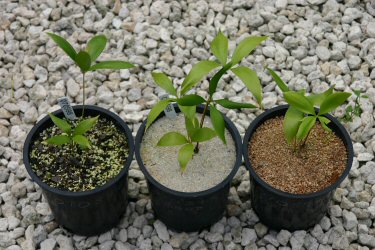Montgomery Botanical Center is dedicated to conserving living collections of cycads. With new living material comingthrough the nursery, the MBC team is often challenged to cultivate plants poorly known to horticulture.
A new paper in the journal HortScience explores the optimum growing medium for new Zamia collections. This study examined the health of seedlings of Z. cunaria, Z. fairchildiana, and Z. aff. portoricensis which were brought to MBC by fieldwork in Panama and Jamaica in 2008. These plants grow in a variety of habitats, and in this study, the plants were grown in a variety of media, including crushed clay, silica sand, and a more traditional mix of organic and inorganic components. The plants varied in caudex diameter and leaf number relative to the media, in accordance with their provenance.
 The study was designed by Dr. Chad Husby, working with Claudia Calonje and Michael Calonje. Chad states: “Determining the proper growing conditions for rare plants requires flexibility and a willingness to experiment. Since fostering good root growth is essential to plant health, finding the best substrates for our collections is crucial to advancing our conservation mission.”
The study was designed by Dr. Chad Husby, working with Claudia Calonje and Michael Calonje. Chad states: “Determining the proper growing conditions for rare plants requires flexibility and a willingness to experiment. Since fostering good root growth is essential to plant health, finding the best substrates for our collections is crucial to advancing our conservation mission.”
Quoting the paper, “Optimizing substrates for cycad propagation is a critical step in ex situ conservation efforts. Predictability of optimal substrate and watering regime relative to native habitat can help increase efficient use of limited resources for these horticulturally unique living fossils.” The MBC team is currently utilizing the findings to advance the cycad program, and further studies are underway.
